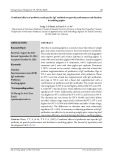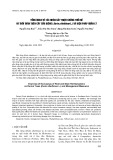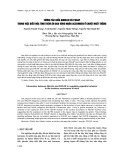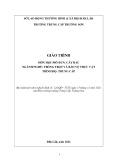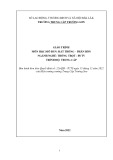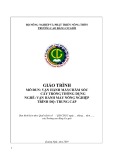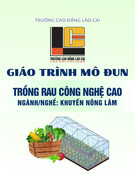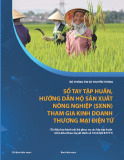
Bu i Hô ng Quân
buihongquan@gbd.edu.vn
090 9 25 24 19
KIM ĐNH SN PHM NÔNG NGHIP


Phần 1: Lý thuyết
Chương 1: Giới thiệu và định nghĩa các sản phẩm nông nghiệp
1.1. Định nghĩa về sản phẩm nông nghiệp
1.2. Giới thiệu về các sản phẩm nông nghiệp
1.3. Đặc tính cơ bản của các sản phẩm nông nghiệp
Chương 2: Cấu trúc và thành phần của các sản phẩm nông nghiệp
2.1. Đặc điểm cấu trúc của các sản phẩm nông nghiệp
2.2. Thành phần hoá học của sản phẩm nông nghiệp
2.3. Sự biến đổi thành phần của sản phẩm nông nghiệp trong quá trình bảô quản
2.4. Các thành phần tạp nhiễm vào sản phẩm nông nghiệp
Chương 3: Các phương pháp kiểm định dư lượng thuốc bảo vệ thực vật
3.1. Phương pháp phân tích truyền thống dư lượng thuốc bảô vệ thực vật
3.2. Phương pháp phân tích đa dư lượng thuốc bảô vệ thực vật (phương pháp
quechers)
3.3. Phương pháp phân tích nhanh dư lượng thuốc bảô vệ thực vật

Chương 4: Các phương pháp kiểm định dư lượng chất kháng sinh
4.1. Phương pháp phân tích chloramphenicol trong thuỷ sản bằng kit ELISA thông qua
phân tích khẳng định bằng LC-MS/MS
4.2. Phương pháp phân tích dư lượng kháng sinh streptomycin
4.3. Phân tích tồn dư kháng sinh nhóm quinolone trong tôm bằng phương pháp ELISA
4.4. Phương pháp phân tích định lượng sulfonamit trong thuỷ sản bằng HPLC
4.5. Phương pháp phân tích nhanh dư lượng thuốc kháng sinh
Chương 5: Các phương pháp kiểm định sinh vật hại trong sản phẩm nông nghiệp
5.1. Các phương pháp phân tích kiểm định vi sinh vật trong sản phẩm nông nghiệp
5.2. Các phương pháp phân tích côn trùng dịch hại trong sản phẩm nông nghiệp
Chương 6: Các phương pháp kiểm định độc tố sinh học trong sản phẩm nông
nghiệp
6.1. Phương pháp truyền thống kiểm định độc tố sinh học trong sản phẩm nông nghiệp
6.2. Các phương pháp phân tích mới kiểm định độc tố sinh học trong sản phẩm nông
nghiệp
6.3. Các phương pháp phân tích nhanh độc tố sinh học trong sản phẩm nông nghiệp

Chương 7: Các phương pháp kiểm định hàm lượng sinh
vật biến đổi gen
7.1. Khái niệm và các vấn đề liên quan đến sinh vật biến đổi
gen
7.2. Sản phẩm nông nghiệp từ sinh vật biến đổi gen
7.3. Các phương pháp phân tích hàm lượng sinh vật biến đổi
gen trong sản phẩm nông nghiệp
Chương 8: Chứng nhận chất lượng sản phẩm nông
nghiệp
8.1. Quy trình chứng nhận chất lượng sản phẩm nông nghiệp
8.2. Tính pháp lý và quy chuẩn chất lượng sản phẩm nông
nghiệp



